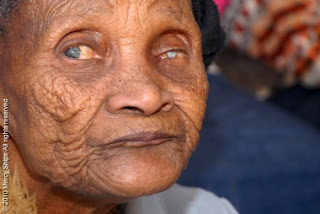 |
| Cataract eye patient waiting in line for screening, hoping to be a candidate for surgery. |
The Mercy Ships Eye Team is headed by Dr. Glenn Strauss, surgeon and lead consultant. They are partnering with The Fred Hollows Foundation South Africa, the Eastern Cape Provincial Department of Health, and management professionals from each hospital to use the current resources most efficiently. The hospitals involved include the Port Elizabeth Hospital Complex, the Nelson Mandela Academic Hospital, and the Sabona Eye Centre in Queenstown. The program will be presented for about three weeks at each hospital.
Hopefully, the Sabona Sonke Campaign will encourage people to use the hospitals more often. For example, the Nelson Mandela Academic Hospital in Mthatha, South Africa, is a fine facility that stands ready to handle the medical needs of the community. However, people do not utilize the hospital to its full potential. One reason is that many people cannot afford needed medical services. Another problem is the prevailing public opinion that the hospital is where one goes to die.
 |
| Close up of a new lens being inserted onto a cataract patient's eye. |
In addition to Dr. Strauss, the Mercy Ships team includes Kim Strauss, patient coordinator; Dr. Richard Newsom, eye surgeon and consultant; Glenys Gillingham, surgical nurse and head of the surgical team; Woody Hopper, consulting optometrist and head of screening; Robin Hopper, educational team leader, administrator and management coordinator; and Shannon Hickey, team member.
Phase one of the program begins with assessment of the current system, training of eye teams, and the transporting of patients to hospital locations. The second phase calls for the training of ophthalmologists in the Mercy Ships expedited procedure of cataract removal, and the referrals of cataract patients to be received at the hospital sites. The final phase includes the cataract operations, assessment and debriefing following the cataract surgeries, and the continuation of the program at future sites.
Screening sites for the Port Elizabeth program were held at Settlers, Uitenhage and Motherwell. The Queenstown screening sites for the Sabona Eye Centre were held at SS Gida Hospital, Aliwal North, Empilisweni and Cofimvaba. Butterworth, St. Elizabeth, St. Patrick and Madzikane kaZulu were the screening sites for the Program at Nelson Mandela Academic Hospital in Mthatha.
Many cataract patients of Optometrist Tseli Khalatha, as well as others who learned about the program by word of mouth, crowded the screening site in Butterworth. They shared a common hope – to have their sight restored. Mr. Khalatha was in charge of admissions at the screening, doing the initial check for cataracts and moving them onto the next step in the process of identifying appropriate patients for the surgery. Robin Hopper and Shannon Hickey did biometry testing to check measurements inside the eye, and Woody Hopper used the slit lamp, a diagnostic tool for cataracts and the final step in the screening process.
Phase II of the program is the training of local eye surgeons. At the Nelson Mandela Academic Hospital in Mthatha, South Africa, surgical candidates arrived by shuttle from the Butterworth screening site and were prepared for cataract surgery. Dr. Strauss and Dr. Richard Newsom, another eye surgeon and consultant, trained surgeons in the Mercy Ships expedited procedure of cataract removal. They worked with Dr. Carolina Salazar, Dr. Laveen Naidoo, and Dr. Thabo Matubatuba of the Mandela Hospital.
 |
| Post Op cataract eye patient 77 yr old Nontombi Ntanjong smiles in appreciation of sight next day after surgery in the Nelson Mandela Academy hospital in Mthatha. |
Dr. Salazar, who came from Cuba to work for only one year in the South African hospital, is now completing her thirteenth year at the facility. “I love the work that he (Dr. Strauss) is doing,” she said. “It's nice to have colleagues around. We all have the same purpose – to help patients.”
Mandoyisile Esther Ntanjana, one of the cataract patients, was totally blind. Her neighbor had also been blind, but had recovered her sight after a similar surgery. The neighbor encouraged Mandoyisile to have the procedure. Mandoyisile's brilliant smile reflected her great joy after the successful surgery. With great excitement, she declared, “I had a dark view before. Now I can see! I am happy!”
Dr. Strauss is working closely with ophthalmologists at each location, and hopes this process will open doors to new strategies for addressing blindness that will be duplicated easily in other areas. In this way, effective eye care will continue after Mercy Ships leaves South Africa.
Story by Elaine B. Winn
Photos by Debra Bell

No comments:
Post a Comment